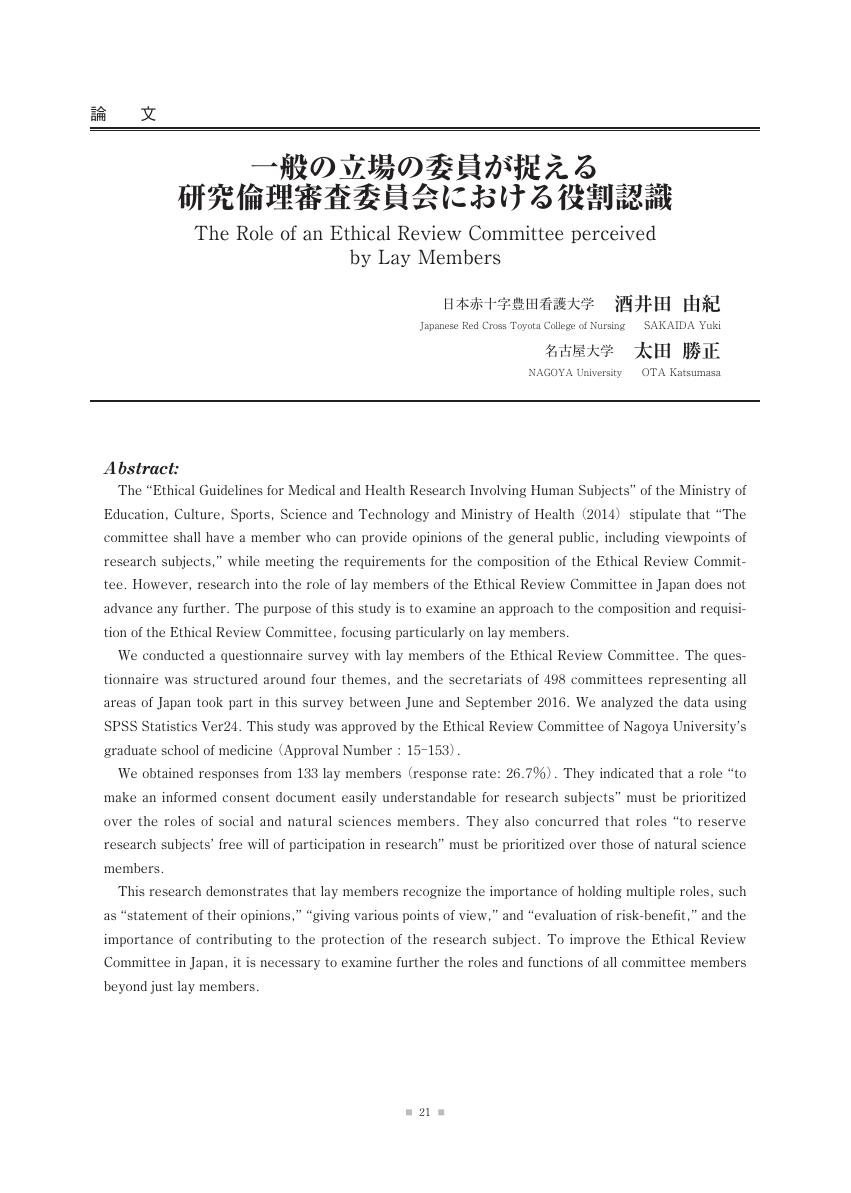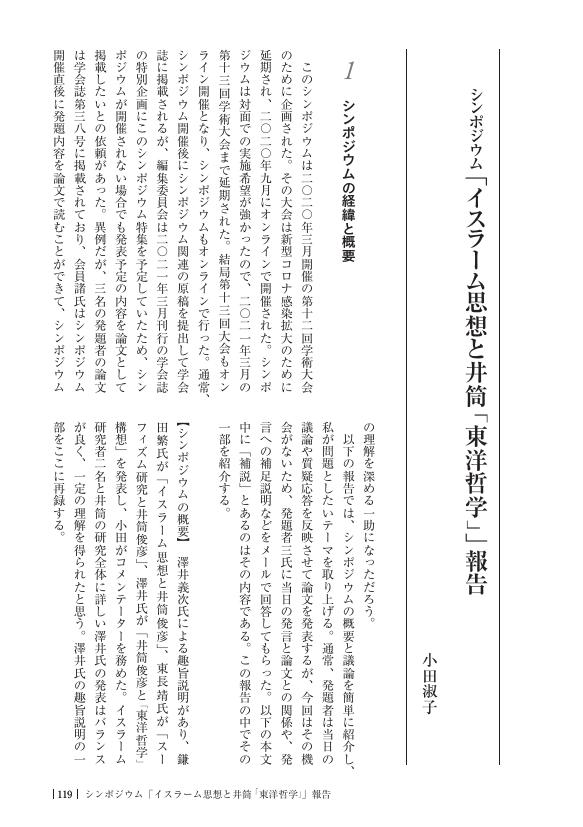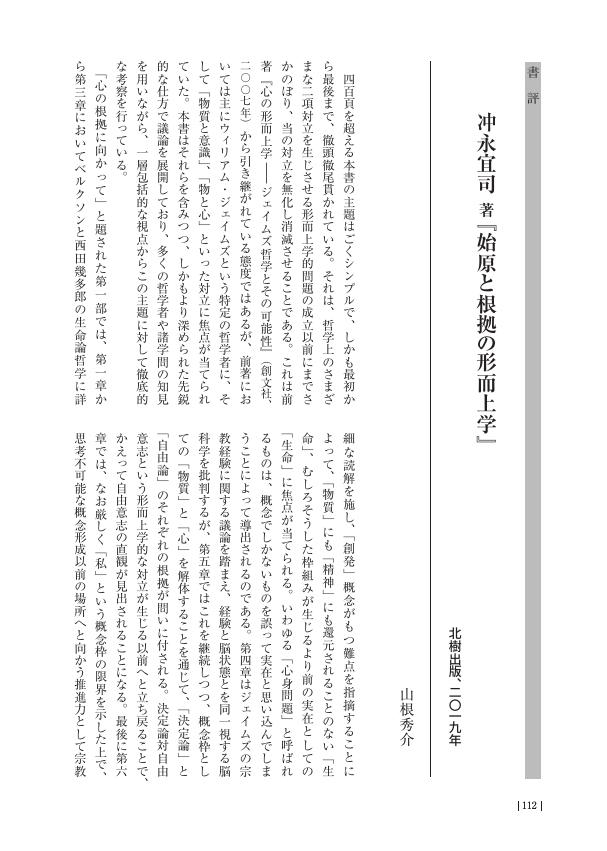1 0 0 0 OA ジェームズ・グリフィンの人権論とその生命倫理的意味
- 著者
- 遠藤 耕二
- 出版者
- 日本医学哲学・倫理学会
- 雑誌
- 医学哲学 医学倫理 (ISSN:02896427)
- 巻号頁・発行日
- vol.36, pp.1-9, 2018 (Released:2022-06-20)
1 0 0 0 OA 着床前遺伝子スクリーニング臨床適用に関する倫理的考察
- 著者
- 児玉 正幸
- 出版者
- 日本医学哲学・倫理学会
- 雑誌
- 医学哲学 医学倫理 (ISSN:02896427)
- 巻号頁・発行日
- vol.36, pp.10-20, 2018 (Released:2022-07-20)
1 0 0 0 OA 一般の立場の委員が捉える 研究倫理審査委員会における役割認識
- 著者
- 酒井田 由紀 太田 勝正
- 出版者
- 日本医学哲学・倫理学会
- 雑誌
- 医学哲学 医学倫理 (ISSN:02896427)
- 巻号頁・発行日
- vol.36, pp.21-31, 2018 (Released:2022-07-20)
1 0 0 0 OA 杉村靖彦・田口茂・竹花洋佑編著『渦動する象徴─田辺哲学のダイナミズム』
- 著者
- 氣多 雅子
- 出版者
- 宗教哲学会
- 雑誌
- 宗教哲学研究 (ISSN:02897105)
- 巻号頁・発行日
- vol.39, pp.110-114, 2022 (Released:2022-06-05)
1 0 0 0 OA ウィルフレッド・キャントウェル・スミス著(保呂篤彦・山田庄太郎訳) 『宗教の意味と終極』
- 著者
- 下田 和宣
- 出版者
- 宗教哲学会
- 雑誌
- 宗教哲学研究 (ISSN:02897105)
- 巻号頁・発行日
- vol.39, pp.115-118, 2022 (Released:2022-06-05)
1 0 0 0 OA シンポジウム「イスラーム思想と井筒「東洋哲学」」報告
- 著者
- 小田 淑子
- 出版者
- 宗教哲学会
- 雑誌
- 宗教哲学研究 (ISSN:02897105)
- 巻号頁・発行日
- vol.39, pp.119-132, 2022 (Released:2022-06-05)
1 0 0 0 OA 恐れ/畏れを生きる 一キリスト教思想史家の視点
- 著者
- 安酸 敏眞
- 出版者
- 宗教哲学会
- 雑誌
- 宗教哲学研究 (ISSN:02897105)
- 巻号頁・発行日
- vol.39, pp.1-13, 2022 (Released:2022-06-05)
The prevailing pandemic caused by the covid-19 has plunged the entire world into anxiety and fear. How does a corona virus multiply itself and infect human beings? How can we cope with the anxiety and fear we feel in face with the covid-19? What on earth are we anxious about? What kind of fear shows itself in the pandemic? A complex of problems raised by the pandemic should be resolved not only by professionals in an infectious disease, specialists in hygiene, physicians, nurses, politicians, policymakers, and economists, but also by philosophers/scientists in religion, theologians, and persons engaged in religious practice. This paper strives to provide an analysis of the corona virus pandemic from the point of view of a historian of Christian thought. Insight into the invisible, the essential role of breath and breathing for human life, something transcendent beyond the boundaries of human reason, and agendas of a theology of kenosis are the main topics of the paper.
1 0 0 0 OA 「仏教改良」の語り方 明治中期における仏教知識人の言説空間を中心として
- 著者
- 呉 佩遥
- 出版者
- 宗教哲学会
- 雑誌
- 宗教哲学研究 (ISSN:02897105)
- 巻号頁・発行日
- vol.39, pp.60-73, 2022 (Released:2022-06-05)
During the mid-Meiji period, the narrative that Buddhism was corrupt, and thus had to be “reformed” to suit modern times, became a growing trend. While previous scholarship has focused on several prominent individuals who engaged in the discourse on the “reform” of Buddhism such as Inoue Enryō and Nakanishi Ushirō, this paper explores how the discourse spread to local Buddhist communities and was interpreted in various ways through Buddhist media. Specifically, this paper focuses on the discourse on the “reform” of Buddhism in the journal Ryōchikai Zasshi, which was established in 1884 and aimed at the philosophical studies of Buddhism. Furthermore, this paper examines how the idea of “reform” was conceived by a lay Buddhist named Tajima Shōji (1852-1909), a renowned journalist and intellectual during this period. Based on the understanding of “religion” as “mokujūkyō” which emphasized obedience to a god, Tajima predicted the decline of Buddhism, with the belief that it could not attract the faith (shinkō) of people. It is noteworthy that with the emphasis on the element of shin in the teaching of Shinshū, Tajima considered this denomination along with Christianity to be the most suitable “religion” for modern Japanese society. Therefore, the cases of the Ryōchikai Zasshi and the work of Tajima reveal the dynamism of the debate of the “reform” of Buddhism, as well as the multifaceted relationship between this discourse and changing views towards Christianity in the mid-Meiji period.
1 0 0 0 OA 武藤一雄における「信仰神秘主義」 キルケゴールの「キリストとの同時性」を中心に
- 著者
- 張 潔
- 出版者
- 宗教哲学会
- 雑誌
- 宗教哲学研究 (ISSN:02897105)
- 巻号頁・発行日
- vol.39, pp.87-100, 2022 (Released:2022-06-05)
This paper presents an interpretation of Kierkegaard’s “Contemporaneity with Christ” as the characteristic of Professor Kazuo Mutō’s (1913-1995) thought that intersects faith and mysticism, which are often considered as opposite concepts, in a way interacting with Keiji Nishitani’s mysticism, to develop Mutō’s own standpoint of the philosophy of religion, namely, theological philosophy of religion. Mutō understood Contemporaneity with Christ from the relationship between faith and ethics to faith-mysticism. He sees Kierkegaard’s mysticism of faith as a bridge between Friedrich Schleiermacher and Karl Barth, to a certain degree reconciling the former, accused of pantheistic mysticism, and the latter, sublimated to supernaturalism. Being between Christianity and the Kyoto School, Mutō believes that faithmysticism is a concept of mysticism inherent in Christianity, which can be traced back to the apostle Paul, or as Mutō put it, back to the New Testament. It represents the paradoxical unity of the transcendence of revelation and the immanence of religious experience, as well as a continuity of discontinuous relationship between Christianity and religions, or between the special revelation and the general revelation.
1 0 0 0 OA 石井公成監修 近藤俊太郎・名和達宣編『近代の仏教思想と日本主義』
- 著者
- 水野 友晴
- 出版者
- 宗教哲学会
- 雑誌
- 宗教哲学研究 (ISSN:02897105)
- 巻号頁・発行日
- vol.39, pp.106-109, 2022 (Released:2022-06-05)
1 0 0 0 OA レヴィナスにおけるデモクラシー論 国家における国家の彼方
- 著者
- 松葉 類
- 出版者
- 宗教哲学会
- 雑誌
- 宗教哲学研究 (ISSN:02897105)
- 巻号頁・発行日
- vol.38, pp.101-111, 2021-03-31 (Released:2021-11-02)
Il est de notoriété commune que le thème de la politique apparaît chez Emmanuel Levinas (1906-1995) dès ses premiers textes. Cependant, au travers du concept du « visage d’autrui dont je réponds » et de sa formule « Politique après ! », la politique est reléguée au second plan derrière l’éthique, qui est la première question philosophique chez Levinas. C’est pourquoi il nous paraît nécessaire de nous demander quelle est la place de la politique après l’éthique, c’est-à-dire comment la première émerge de la seconde.Afin de répondre à cette question, nous nous appuyons sur son discours talmudique « Au-delà de l’État dans l’État » (1988). Levinas y définit la démocratie comme une incarnation de l’éthique, et non comme un régime politique. Jacques Derrida (1930-2004) a également traité le problème de la démocratie dans son texte « Le Mot d’accueil » (1996), présenté lors d’une conférence en mémoire de Levinas. Dans ce texte, il décrit la relation entre l’éthique et la politique comme un « hiatus » en se référant à la définition de la démocratie donnée par Levinas. Cependant, l’interprétation du terme « démocratie » par Derrida semble différer de celle proposée par Levinas. En effet, chez Derrida, la démocratie se conçoit exclusivement comme un régime politique à part entière, tandis qu’elle peut s’incarner dans la politique quel que soit le régime chez Levinas.
1 0 0 0 OA 冲永宜司著『始原と根拠の形而上学』
- 著者
- 山根 秀介
- 出版者
- 宗教哲学会
- 雑誌
- 宗教哲学研究 (ISSN:02897105)
- 巻号頁・発行日
- vol.38, pp.112-115, 2021-03-31 (Released:2021-11-02)
1 0 0 0 OA 水野友晴著『「世界的自覚」と「東洋」――西田幾多郎と鈴木大拙』
- 著者
- 末村 正代
- 出版者
- 宗教哲学会
- 雑誌
- 宗教哲学研究 (ISSN:02897105)
- 巻号頁・発行日
- vol.38, pp.116-119, 2021-03-31 (Released:2021-11-02)
1 0 0 0 OA 小野真龍著『雅楽のコスモロジー ――日本宗教式楽の精神史』
- 著者
- 水野 友晴
- 出版者
- 宗教哲学会
- 雑誌
- 宗教哲学研究 (ISSN:02897105)
- 巻号頁・発行日
- vol.38, pp.120-123, 2021-03-31 (Released:2021-11-02)
1 0 0 0 OA 堀江宗正著『ポップ・スピリチュアリティ――メディア化された宗教性』
- 著者
- 後藤 正英
- 出版者
- 宗教哲学会
- 雑誌
- 宗教哲学研究 (ISSN:02897105)
- 巻号頁・発行日
- vol.38, pp.124-128, 2021-03-31 (Released:2021-11-02)
1 0 0 0 OA 澤井義次著『ルードルフ・オットー――宗教学の原点』
- 著者
- 鶴岡 賀雄
- 出版者
- 宗教哲学会
- 雑誌
- 宗教哲学研究 (ISSN:02897105)
- 巻号頁・発行日
- vol.38, pp.129-133, 2021-03-31 (Released:2021-11-02)
1 0 0 0 OA 芦名定道著『現代神学の冒険――新しい海図を求めて』
- 著者
- 佐藤 啓介
- 出版者
- 宗教哲学会
- 雑誌
- 宗教哲学研究 (ISSN:02897105)
- 巻号頁・発行日
- vol.38, pp.134-137, 2021-03-31 (Released:2021-11-02)
1 0 0 0 OA 井筒俊彦とイスラーム神秘哲学
- 著者
- 鎌田 繁
- 出版者
- 宗教哲学会
- 雑誌
- 宗教哲学研究 (ISSN:02897105)
- 巻号頁・発行日
- vol.38, pp.1-14, 2021-03-31 (Released:2021-11-02)
Izutsu has left works in different fields of Islamic studies, especially in semantic studies of the Qur’ān and in mystical philosophy. To clarify what aspects of Islamic thought he was interested in, I took up two mystic thinkers he discussed, namely, ‘Aynal-Quḍāt al-Hamadānī (d.1131) and Mullā Ṣadrā (d.1640). ‘Ayn al-Quḍāt offers two different points of view concerning to Reality, the domain of reason (ṭawr al-‘aql) and the domain beyond reason (al-ṭawr warā’ al-‘aql). A mystic wayfarer does not proceed to the higher realm beyond reason without receiving of divine illumination. Mullā Ṣadrā logically formulates the thesis of the fundamental reality of existence together with those of the analogical gradation and the substantial movement. His reasoning is supported by his mystical experience, in which he intuitively grasped that diversified phenomena of the world were different forms of manifestation of Existence as the sole Reality. Both of them in Izutsu’s understanding equally stress importance of mystical experience in their thought. In his last book on the Qur’ān (Koran wo yomu, 1983) Izutsu presents a unique idea that some passages of the Qur’ān can be understood as originating from the depth of consciousness, which is the main field of activity for mystic imagination. He finds a mystical aspect in the Qur’ān. In this way Izutsu’s study of Islam is characterized by his focusing on the mystical aspect.
1 0 0 0 OA スーフィズム研究と井筒俊彦
- 著者
- 東長 靖
- 出版者
- 宗教哲学会
- 雑誌
- 宗教哲学研究 (ISSN:02897105)
- 巻号頁・発行日
- vol.38, pp.15-24, 2021-03-31 (Released:2021-11-02)
This paper examines the place of Toshihiko Izutsu’s approach in Sufi studies. Non-specialists in Sufism seem to generally assume that Izutsu’s approach falls in line with mainstream Sufi studies around the world, and that Ibn ‘Arabī and the school he founded were subjects for Izutsu’s works, which has subsequently become a theme of primary interest in Sufi studies. These views are misguided, however. Approaches to Sufism may be classified as (a) sharī‘a-oriented vs. ḥaqīqa-oriented Sufism, (b) elite Sufism vs. common people’s Sufism, and (c) Islamic Sufism vs. universal Sufism. Izutsu mainly focused on ḥaqīqa-oriented universal Sufism as practiced by elites; however, the general understanding of Sufism among scholars in the Islamic world does not always share this focus, instead emphasizing the ethical aspects of Sufism, which are closely related to sharī‘a-oriented Sufism. Moreover, they devote attention to not only the elites, but also the common people, especially regarding tariqa and saint veneration, both of which are generally believed to have close connections with Sufism. Their main concern is Sufism in the Islamic milieu, rather than universal mysticism.
- 著者
- 東長 靖
- 出版者
- 宗教哲学会
- 雑誌
- 宗教哲学研究 (ISSN:02897105)
- 巻号頁・発行日
- vol.38, pp.159, 2021 (Released:2021-11-02)
編集作業終了後に著者から以下のような訂正依頼がありました。












